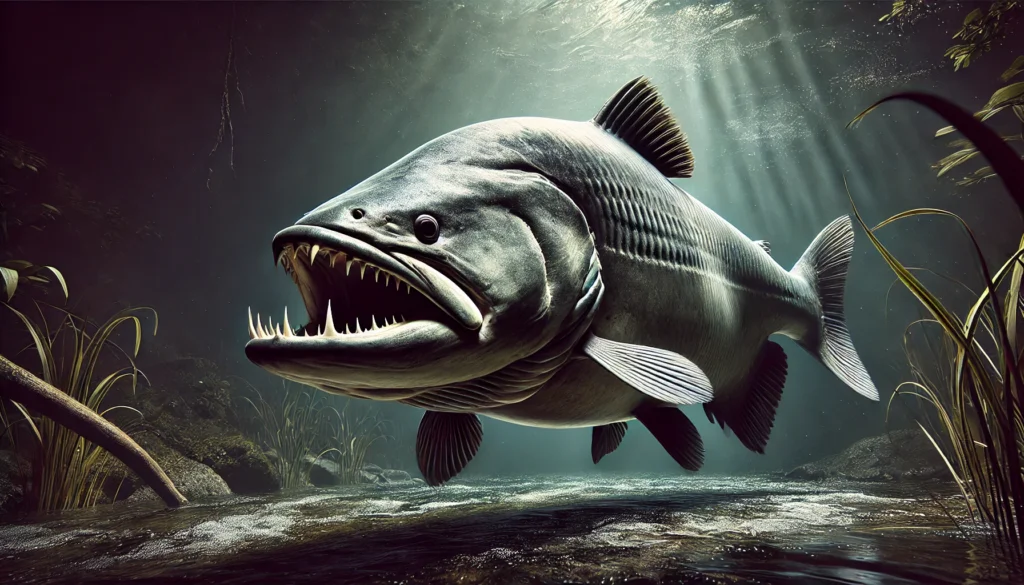The Goliath Tigerfish is often referred to as the apex predator of Africa’s river systems. With its razor-sharp teeth, powerful body, and ferocious hunting abilities, this fish has earned a fearsome reputation. Found in the Congo River Basin and Lake Tanganyika, the Goliath Tigerfish is notorious for its aggressive nature and is sometimes likened to a freshwater version of a piranha.
This article will dive deep into the fascinating world of the Goliath Tigerfish, exploring its biology, hunting strategies, and why it’s considered one of the most dangerous freshwater fish on the planet.
A Monster of the Water: Physical Characteristics
The Goliath Tigerfish (Hydrocynus goliath) is a truly formidable predator. Growing up to 5 feet (1.5 meters) in length and weighing as much as 110 pounds (50 kg), it is one of the largest and strongest freshwater fish in Africa. Its body is built for power and speed, with streamlined silver scales that allow it to move through turbulent waters with ease.
The most iconic feature of the Goliath Tigerfish is its teeth. Each of its dagger-like teeth can grow over an inch in length, protruding from its jaw even when its mouth is closed. These teeth are designed to slice through flesh effortlessly, making the Goliath Tigerfish a highly effective hunter. Its jaws are lined with 32 to 36 of these sharp, conical teeth, resembling those of sharks and allowing it to capture and devour prey in a matter of seconds.
Key Physical Features:
- Length: Up to 5 feet (1.5 meters)
- Weight: Up to 110 pounds (50 kg)
- Teeth: Sharp, needle-like teeth, over an inch long
- Color: Silvery, reflective scales
Habitat: The Rivers of Africa
Goliath Tigerfish are native to the Congo River Basin, one of the most powerful and complex river systems in the world. The fast-flowing, murky waters of the Congo provide the perfect hunting grounds for these predators. They thrive in large, deep rivers with strong currents, where they can ambush prey with lightning speed.
The fish are also found in Lake Tanganyika, one of Africa’s Great Lakes, where they inhabit the deeper, more secluded areas. The challenging environment of these water bodies, filled with debris, rapids, and murky depths, creates an ideal setting for the Goliath Tigerfish’s ambush-style hunting tactics. These fish prefer regions with plenty of cover, such as submerged trees and rocks, which provide hiding spots from which they can launch attacks on unsuspecting prey.
Key Habitat Details:
- Region: Congo River Basin, Lake Tanganyika
- Preferred Environment: Deep rivers with strong currents and murky waters
- Cover: Submerged vegetation, rocks, and fallen trees
Apex Predator: Hunting Techniques and Diet
The Goliath Tigerfish is a carnivore that relies on its speed, strength, and sharp teeth to capture prey. It is an ambush predator, often lurking in the shadows of its murky habitat, waiting for the right moment to strike. When it spots a target, the Goliath Tigerfish can accelerate rapidly, using its muscular body to swim up to speeds of 30 miles per hour. This burst of speed allows it to overtake even the fastest fish in the river.
Goliath Tigerfish primarily feed on other fish, including smaller tigerfish and even their own species. They have been observed taking down large prey, including sizable catfish and cichlids. Their hunting method involves swimming beneath their prey and striking from below, using their sharp teeth to sever the spinal cords of their targets.
One of the reasons Goliath Tigerfish are so effective as hunters is their ability to sense vibrations in the water. These vibrations help them detect the movements of prey, even in the dark or murky conditions of the Congo River. Their excellent vision also enables them to locate and track prey over long distances.
Diet and Hunting Tactics:
- Diet: Fish, including catfish, smaller tigerfish, and cichlids
- Hunting Style: Ambush predator, strikes from below with powerful bursts of speed
- Sensory Abilities: Detects water vibrations and has sharp vision for tracking prey
Fearsome Reputation: The Goliath Tigerfish in Local Lore
In the regions where the Goliath Tigerfish is found, it has long been the subject of local myths and stories. Known as mbenga by some tribes, this fish is revered—and feared—by local fishermen and villagers. Some legends describe it as a supernatural creature, capable of sinking small boats and attacking people. While actual attacks on humans are rare, the Goliath Tigerfish’s formidable size and sharp teeth make it a creature that commands respect.
The fish’s reputation as a dangerous predator has been enhanced by tales of its immense strength. There are stories of Goliath Tigerfish leaping out of the water to snatch birds or even small mammals that venture too close to the river’s edge. Whether these stories are true or exaggerated, they contribute to the fish’s status as one of Africa’s most fearsome freshwater creatures.
Folklore and Myths:
- Local Name: Mbenga
- Myths: Stories of attacking boats, leaping from the water to catch birds
- Superstitions: Revered and feared by local tribes
Fishing for Goliath Tigerfish: A Sport Fisherman’s Dream
Catching a Goliath Tigerfish is considered a prize achievement for sport fishermen, many of whom travel to the Congo River Basin specifically to seek out this powerful predator. Due to their size, strength, and aggressive nature, these fish provide a thrilling challenge for anglers. Goliath Tigerfish are known to put up an intense fight when hooked, often leaping out of the water and thrashing violently in an attempt to break free.
The sheer strength of these fish means that heavy-duty fishing gear is required to catch them. Anglers often use strong lines, heavy rods, and sharp hooks to withstand the force of a Goliath Tigerfish on the line. Fishing for this species is not for the faint of heart; it requires patience, strength, and a willingness to face one of nature’s most fearsome predators.
Sport Fishing Highlights:
- Highly Sought-After: A challenging catch for experienced anglers
- Fighting Power: Known for their strength and violent thrashing when hooked
- Required Equipment: Heavy-duty fishing rods, strong lines, and sharp hooks
Reproduction and Lifecycle
Like many large fish species, Goliath tigerfish follow a seasonal reproductive cycle. They typically spawn during the rainy season when the water levels rise, creating the ideal conditions for breeding. The increased flow of water allows the fish to migrate to shallow areas where they can lay their eggs in relative safety. These shallow waters are also rich in nutrients, providing an abundant food source for the young fish once they hatch.
The eggs hatch into larvae, which are vulnerable to predation from other fish, including adult tigerfish. However, the rapid growth rate of Goliath tigerfish helps them survive their early life stages. As they mature, they move into deeper waters, where they gradually become formidable predators in their own right.
Tigerfish grow quickly, reaching sizes of several feet within a few years. Their long lifespan and lack of natural predators allow them to dominate their ecosystem for many years, with some specimens living for over a decade.
Conservation Status: The Challenges Facing Goliath Tigerfish
While the Goliath Tigerfish is not currently listed as an endangered species, there are growing concerns about the future of its population. Like many large freshwater species, Goliath Tigerfish face threats from overfishing, habitat destruction, and environmental changes. In regions where the fish are heavily targeted by sport fishermen or for commercial purposes, their numbers have begun to decline.
Habitat degradation, particularly in the Congo River Basin, is another issue. Deforestation, pollution, and dam construction are altering the river’s ecosystem, impacting the delicate balance of life that the Goliath Tigerfish relies on. The loss of habitat not only reduces the available space for the fish to hunt and breed but also affects the populations of prey species, further disrupting the food chain.
Conservation efforts are needed to protect the habitat of the Goliath Tigerfish and ensure that this fearsome predator remains a part of Africa’s river ecosystems for generations to come.
Conservation Concerns:
- Threats: Overfishing, habitat destruction, environmental changes
- Habitat Loss: Deforestation, pollution, and dam construction impact river ecosystems
- Conservation Needs: Protection of the Congo River Basin and responsible fishing practices
Myth vs. Reality
The Goliath tigerfish’s fearsome reputation has given rise to many myths and legends, particularly among local communities that live near the Congo River. Known locally as “mbenga,” the fish is both revered and feared. Stories abound of the tigerfish attacking canoes, biting through fishing nets, and even dragging small animals into the water. These tales have elevated the Goliath tigerfish to a near-mythical status, with many seeing it as a dangerous man-eater.
While it is true that the Goliath tigerfish is a formidable predator, its reputation as a killer of humans is largely exaggerated. Documented cases of tigerfish attacks on humans are extremely rare, and they are typically defensive in nature. Most of the time, the fish’s interactions with humans are limited to accidental encounters during fishing expeditions.
Despite this, the Goliath tigerfish’s powerful bite and aggressive hunting tactics make it a fish that commands respect. Anglers from around the world travel to Africa in the hopes of catching this “river monster,” adding to its legendary status.
Separating Fact from Fiction:
- Myth: Stories of tigerfish attacking humans are largely exaggerated.
- Reality: It is a fierce predator, but it is not a man-eater.
- Legendary status: Revered by local communities and sought after by adventurous anglers.
Conclusion
The Goliath Tigerfish stands out as one of the fiercest and most awe-inspiring predators in the world’s rivers. With its enormous size, razor-sharp teeth, and incredible speed, it dominates the waters of the Congo River Basin. Whether viewed through the lens of local folklore or admired by sport fishermen for its fighting spirit, the Goliath Tigerfish commands respect. While not yet endangered, the species faces growing environmental pressures that require attention to ensure it continues to thrive in its natural habitat.
FAQ
What is the Goliath Tigerfish?
The Goliath Tigerfish (Hydrocynus goliath) is a large freshwater predator native to the Congo River Basin and Lake Tanganyika in Africa. Known for its sharp teeth and aggressive nature, it is one of the most fearsome fish in the world.
How big do Goliath Tigerfish get?
Goliath Tigerfish can grow up to 5 feet (1.5 meters) in length and weigh up to 110 pounds (50 kg).
Are Goliath Tigerfish dangerous to humans?
While Goliath Tigerfish are capable of inflicting serious injuries with their sharp teeth, attacks on humans are extremely rare. They are generally more interested in hunting fish.
What do Goliath Tigerfish eat?
They primarily eat fish, including smaller tigerfish, catfish, and cichlids. They use their sharp teeth to capture and kill their prey with precision.
Why are Goliath Tigerfish popular among sport fishermen?
Goliath Tigerfish are highly prized by sport fishermen due to their size, strength, and aggressive behavior, making them a challenging and exciting catch.
What threats do Goliath Tigerfish face?
The main threats to Goliath Tigerfish include overfishing, habitat destruction, and environmental changes, particularly in the Congo River Basin. Conservation efforts are needed to protect their habitat and population.


